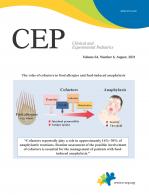Pulmonary thromboembolism (PTE) is often diagnosed in children with underlying medical disorders, and a meta-analysis reported that its prevalence among patients with nephrotic syndrome was 7.93% [1]. Patients with nephrotic syndrome have a hypercoagulable state caused by several factors, such as abnormalities in platelet activation (increased number and aggregation) and an imbalance between anticoagulation/antithrombosis (decreased antithrombin III levels) and procoagulant/prothrombotic mechanisms (increased factor V, factor VII, and fibrinogen levels), leaving them at increased risk for deep venous and arterial thrombosis, renal vein thrombosis, and PTE [2,3].
Thromboembolic complications tend to present more severely, which may be associated with severe hypoalbuminemia in children with nephrotic syndrome [4]. Additionally, the thromboembolic risk is higher in adolescents with nephrotic syndrome than in children. In a report by You et al. [5], an adolescent had persistent proteinuria and hypoalbuminemia despite steroid therapy and was at risk for thromboembolism. However, prophylactic anticoagulation is not usually recommended because of a lack of large randomized trials and guidelines [2].
PTE symptoms include pleuritic chest pain, shortness of breath, and hemoptysis, and its diagnosis can be missed or delayed in children due to its nonspecific symptoms and difficulty assessing pain in young children [6]. Thus, the physicianŌĆÖs suspicion is highly necessary to diagnose PTE [6]. In patients with nephrotic syndrome, a high plasma D-dimer level was associated with the occurrence of PTE [7]. Regarding underlying etiologic factors, it is possible that children with nephrotic syndrome and PTE may have other thrombophilia states such as anticardiolipin antibody, antithrombin deficiency, and protein C and S deficiencies, and it may be necessary to evaluate the presence of risk factors in addition to nephrotic syndrome [8].
The management guidelines in children are extrapolated from adult data, and treatment includes thrombolysis or thrombectomy and pharmacologic anticoagulation [8]. Anticoagulation should be initiated with a rapid-acting agent, either unfractionated or low-molecular-weight heparin, followed by continued anticoagulation with low-molecular-weight heparin or a vitamin K antagonist [9,10]. Low-molecular-weight heparin is now widely used in children. There is no consensus regarding the duration of therapy, with the American College of Chest Physicians (ACCP) guidelines recommending anticoagulation for 3 months or until resolution of the precipitating risk factor for secondary PTE and longer anticoagulation of 6ŌĆō12 months for idiopathic PTE [9]. You et al. [5] reported a case in which extracorporeal membrane oxygenation (ECMO) with anticoagulation was helpful for a life-threatening condition caused by massive PTE in children with nephrotic syndrome. Massive PTE can cause hemodynamic instability, right ventricular failure, and circulatory collapse [8]. According to the 2016 ACCP Antithrombotic Guidelines, therapy for massive PTE should include systemic thrombolytic therapy combined with anticoagulation and supportive care [9]. Systemic thrombolysis generally requires an intravenous infusion of 50ŌĆō100 mg tissue plas-minogen activator over 1ŌĆō2 hours and carries a 20% risk of major bleeding and 2%ŌĆō5% risk of hemorrhagic stroke [11]. However, in patients in whom systemic thrombolytics are contraindicated, ECMO and/or surgical embolectomy may be used to improve oxygenation, achieve hemodynamic stability, and successfully treat massive PTE [8]. The European Society of Cardiology 2014 guidelines state that ECMO can be used for massive PTE as a method of hemodynamic support and adjunct to surgical embolectomy [12]. Additionally, ECMO can be applied in the setting of massive PTE and hemodynamic instability, when invasive diagnostic studies are not feasible and urgent intervention is warranted [7].
In conclusion, the prevalence of PTE is increasing in children, and physiciansŌĆÖ suspicion is important for prompt diagnosis, especially if there is an underlying cause such as nephrotic syndrome [13]. The rapid initiation of anticoagulation is important for favorable outcomes, and ECMO may be helpful when the patient is hemodynamically unstable.





 PDF Links
PDF Links PubReader
PubReader ePub Link
ePub Link PubMed
PubMed Download Citation
Download Citation


